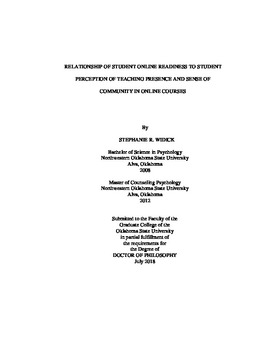| dc.contributor.advisor | Montgomery, Diane | |
| dc.contributor.author | Widick, Stephanie R. | |
| dc.date.accessioned | 2019-03-20T19:25:39Z | |
| dc.date.available | 2019-03-20T19:25:39Z | |
| dc.date.issued | 2018-07 | |
| dc.identifier.uri | https://hdl.handle.net/11244/317648 | |
| dc.description.abstract | Various dimensions of online readiness are related to online student success and student engagement in the online class (Hung, Chou, Chen, & Own, 2010) Likewise, teaching presence, an element of the Community of Inquiry theory, is related to online student success (Garrison, Anderson, & Archer, 2000). A relationship has been found with online readiness and sense of community (Shea, Li, & Pickett, 2006). Yet, little is known about the direct relationship of the dimensions of online readiness to student perception of teaching presence and sense of community in the fully-online course. The purpose of this study was to determine the relationship of student online readiness to student perception of teaching presence and sense of community in fully-online undergraduate courses. Correlation and multiple regression analyses were run in order to examine the relationship between five dimensions of online readiness computer/Internet self-efficacy (CISE), self-directed learning (SDL), learner control (LC), motivation to learn (ML), and online communication self-efficacy (OCSE) to student perception of teaching presence and sense of community in the online classroom. Results indicated a significant negative relationship of CISE and SDL to teaching presence; whereas, there were significant positive relationships with LC, ML, and OCSE to teaching presence. Regression analysis resulted in SDL as the only significant predictor of teaching presence, and it was negative. | |
| dc.description.abstract | Furthermore, the analysis of the relationship of these five dimensions of online readiness to class community resulted in no relationship to CISE, a positive relationship to SDL, and negative relationships to LC, ML, and OCSE. | |
| dc.description.abstract | Conclusions indicate that as learners become more self-directed in learning online, the perception of teaching presence decreases; yet, perception of sense of community increases. Another conclusion is that as the dimensions of LC, ML, and OCSE increase, so do the perceptions about teaching presence; however, sense of community decreases. Negative predictive value to teaching presence needs further study. The relationship of the dimensions of online readiness resulted in a negative relationship between teaching presence and sense of community. | |
| dc.description.abstract | By examining the relationship of student online readiness to perception of teaching presence and sense of community, this study contributes insight for researchers to continue to investigate specific ways instructors can prepare for online courses. | |
| dc.format | application/pdf | |
| dc.language | en_US | |
| dc.rights | Copyright is held by the author who has granted the Oklahoma State University Library the non-exclusive right to share this material in its institutional repository. Contact Digital Library Services at lib-dls@okstate.edu or 405-744-9161 for the permission policy on the use, reproduction or distribution of this material. | |
| dc.title | Relationship of student online readiness to student perception of teaching presence and sense of community in online courses | |
| dc.contributor.committeeMember | Koch, Julie | |
| dc.contributor.committeeMember | May, Jim | |
| dc.contributor.committeeMember | Thompson, Penny | |
| osu.filename | Widick_okstate_0664D_15841.pdf | |
| osu.accesstype | Open Access | |
| dc.type.genre | Dissertation | |
| dc.type.material | Text | |
| thesis.degree.discipline | Educational Psychology | |
| thesis.degree.grantor | Oklahoma State University | |
